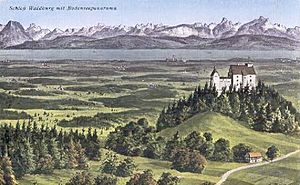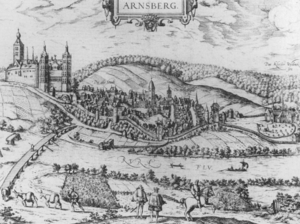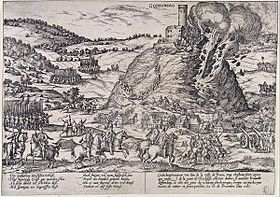Gebhard Truchsess von Waldburg facts for kids
Quick facts for kids Gebhard Truchsess von Waldburg |
|
|---|---|
| Elector-Archbishop of Cologne | |

Portrait by Hermann tom Ring, 1579
|
|
| Prince-Elector-Archbishop of Cologne | |
| Reign | 3 October 1577 – 1588 |
| Predecessor | Salentin VII of Isenburg-Grenzau |
| Successor | Ernst of Bavaria |
| Dean, Strasbourg Cathedral | |
| Tenure | 1574 |
| Provost, Augsburg Cathedral | |
| Tenure | 1576 |
| Born | 10 November 1547 Heiligenberg |
| Died | 31 May 1601 (aged 53) Strasbourg |
| Burial | Strasbourg Cathedral |
| House | House of Waldburg |
| Father | William Seneschal of Waldburg |
| Mother | Johanna von Fürstenberg |
| Religion | Roman Catholic (until 1582) Calvinist (from 1582) |
Gebhard Truchsess von Waldburg (born 10 November 1547 – died 31 May 1601) was an important leader in Germany. He held the powerful position of Archbishop-Elector of Cologne. This meant he was both a religious leader (Archbishop) and a political leader (Elector) who helped choose the Holy Roman Emperor.
Gebhard was chosen for this role after a close election. Later, he fell in love with and married Agnes von Mansfeld-Eisleben, who was a Protestant. This was a big deal because Gebhard was a Catholic leader. When he changed his religion to Calvinism and said that both Catholics and Calvinists should have equal rights in his territory, it caused a huge conflict. This conflict led to a war known as the Cologne War.
The war lasted for six years, with a lot of fighting and destruction. Eventually, Gebhard gave up his claim to the Electorate and moved to Strasbourg. His actions were a major test for a rule called the ecclesiastical reservation, which was part of the Peace of Augsburg agreement from 1555. His defeat helped strengthen the Catholic side in northern Germany and increased the power of the Wittelsbach family in politics.
Contents
Gebhard's Early Life and Family
Gebhard was born on November 10, 1547, in the Heiligenberg fortress. He was the second son of William, who was a noble and an Imperial Councilor, and his mother, Johanna v. Fürstenberg. His family, the House of Waldburg, was very old and important in the region of Swabia. They owned a lot of land.
Gebhard's grandfather was a military commander. His great-uncle, Jörg Truchsess von Waldburg, was also a famous commander during the Peasant Wars in 1525. Gebhard's uncle, Otto, was a bishop and later a Cardinal. He even founded a university.
Because he was a younger son, Gebhard was prepared for a career in the church from a young age. He received a good education and learned several languages, including Latin, Italian, French, and German. He studied history and religion at different universities.
He started his church career in 1560 at Augsburg. He held several positions in cathedrals in Cologne, Strassburg, Ellwangen, and Würzburg. These positions meant he received money, which was common for nobles in the church at that time. In 1576, he became the provost of the Cathedral in Augsburg.
In December 1577, Gebhard was chosen as the Elector of Cologne. He won the election by just two votes against Ernst of Bavaria. Although it wasn't strictly required, Gebhard agreed to become a priest, which his predecessor had not done. The first few years of his time as Elector were peaceful. He continued some projects started by the previous Elector, like rebuilding a castle.
The Archbishop Goes to War
Gebhard is most famous for changing his religion and for his marriage to Agnes von Mansfeld-Eisleben. Agnes was a canoness, which is a type of religious woman, from Gerresheim. After being together for two years, Gebhard decided to marry her. He likely planned to give up his church position when he married, as was the custom.
However, some of his Protestant supporters encouraged him to keep his position as Elector. In December 1582, he officially announced that he had become a Protestant (Calvinist). He also declared that Calvinists and Catholics would have equal rights in his territory. His marriage to Agnes took place on February 4, 1583. Gebhard then tried to keep his powerful position. This caused a big problem in the Holy Roman Empire.
The Peace of Augsburg agreement had a rule called ecclesiastical reservation. This rule said that if a Catholic church leader converted to Protestantism, they had to give up their church position and lands. Gebhard's friends argued he could keep his office, while his enemies insisted he must resign. Unlike previous leaders who had converted or married and then resigned, Gebhard did not. He also adopted John Calvin's teachings, which were not approved in the 1555 Augsburg agreement. This angered the Catholic leaders in Cologne.
Gebhard prepared for conflict by gathering some troops. In April 1583, Pope Gregory XIII removed him from the church (excommunicated him). Ernest, who had lost the election to Gebhard, was chosen as the new Elector. Gebhard was supported by Adolf von Neuenar and his own brother, Karl. He tried to get help from other Protestant leaders in Germany, but they were not eager to support him because he was a Calvinist, not a Lutheran.
While leaders tried to find a peaceful solution, armies from both sides fought in the southern part of the Electorate. They plundered religious buildings, burned villages, and destroyed crops. Neither side wanted a big, decisive battle. Instead, they used their armies to intimidate people, besiege towns, and disrupt trade.
By March 1583, Gebhard and Agnes were forced to flee from Bonn and Bad Godesberg. They sought safety in the Netherlands with William I of Orange. They tried to get support from Queen Elizabeth I of England, but their efforts did not lead to more help for the war.
By 1588, Gebhard's health made it difficult for him to ride a horse. He gave up his claim to the Electorate. In the summer of 1588, Gebhard moved to Strassburg, where he had held a church position since 1574.
Results of Gebhard's Actions
Gebhard's decision to convert and marry had a huge impact. It led to a lot of destruction and loss of life. His defeat was a major setback for Protestantism in northern Germany. It also helped the Catholic counter reformation movement.
After Gebhard's defeat, Catholic Jesuits went to the Electorate to bring people back to Catholicism, sometimes using force. The war also allowed Spanish troops to enter the Rhineland. Spain needed a land route to fight the rebellious Dutch, and by helping Ernest, they gained important positions in the Rhine valley. The Cologne War showed that religious conflicts in Germany were becoming an international issue, which eventually led to the terrible Thirty Years Wars.
Later Life and Legacy
In 1589, Gebhard and Agnes settled in Strasbourg. He continued to hold his church position there until his death. He even became involved in a dispute within the church chapter in Strasbourg.
Gebhard had written a will in 1583, leaving his property to his brother, Karl, and providing for Agnes. When Karl died in 1593, Gebhard changed his will to ensure Agnes would be cared for by the Duke of Württemberg. Gebhard spent his last years struggling with illness. He died on May 31, 1601, and was buried with his brother Karl in the Strasbourg Cathedral.
Historians have different opinions about Gebhard. Some say he was not a very important person himself, but his actions caused a lot of change. Others criticize him for acting without thinking, leading to disaster for himself and Germany. They often see both Gebhard and his rival Ernest as being controlled by larger forces during the war.
See also
 In Spanish: Gebhard Truchsess von Waldburg para niños
In Spanish: Gebhard Truchsess von Waldburg para niños





